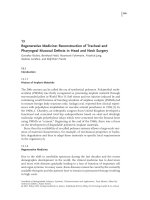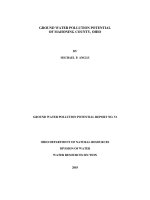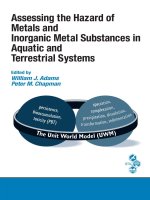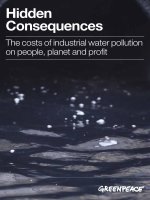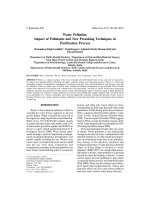Water Pollution: Impact of Pollutants and New Promising Techniques in Purification Process doc
Bạn đang xem bản rút gọn của tài liệu. Xem và tải ngay bản đầy đủ của tài liệu tại đây (52.49 KB, 7 trang )
© Kamla-Raj 2012 J Hum Ecol, 37(2): 103-109 (2012)
Water Pollution:
Impact of Pollutants and New Promising Techniques in
Purification Process
Ramandeep Singh Gambhir
1*
, Vinod Kapoor
2
, Ashutosh Nirola
3
, Raman Sohi
4
and
Vikram Bansal
4
1
Department of Public Health Dentistry,
2
Department of Oral and Maxillofacial Surgery,
Gian Sagar Dental College and Hospital, Rajpura, India
3
Department of Periodontology, Laxmi Bai Dental College and Research Centre,
Patiala, India
4
Department of Public Health Dentistry, M.M. College of Dental Sciences and Research,
Mullana, Ambala, India
KEYWORDS Water Pollution. Wastes. Water Treatment. New Techniques. Pure Water
ABSTRACT Water is a critical resource in the lives of people who both benefit from its use and who are harmed by
its misuse and unpredictability (flooding, droughts, salinity, acidity, and degraded quality). Water is a finite and
vulnerable resource. Consequently, consumption of polluted water puts lives and livelihoods at risk because water has
no substitute. There are many ways in which water intended for human consumption can get polluted. These include
wastes from industries like mining and construction, food processing, radioactive wastes from power generating
industries, domestic and agricultural wastes and by various microbiological agents. Nowadays, water is being purified by
various methods but research is being conducted to look for more reliable and cheaper methods that can purify water
at an affordable cost. Various techniques have been developed like utilizing rechargeable polymer beads, seeds of
Moringa Oleifera tree, aerobic granular sludge technology, resin based treatment and two-pronged water treatment
technology.
*Corresponding author:
Dr Ramandeep Singh Gambhir
Gian Sagar Dental College and Hospital,
Rajpura 140 601,
Punjab, India
Telephone: +91 9915646007,
Fax: +91 1762 520011,
E-mail:
INTRODUCTION
Water is that chemical substance which is
essential for every living organism to survive
on this planet. Water is needed by every cell of
the organism’s body to perform normal function.
Water covers 71% of the Earth’s surface, mostly
in oceans and other large water bodies, with 1.6%
of water below ground in aquifers and 0.001% in
the air as vapor, clouds and precipitation (U.S.
Geological Survey 2000). Water moves conti-
nually through a cycle of evaporation or transpi-
ration (evapotranspiration), precipitation, and
runoff, usually reaching the sea. Winds carry
water vapor over land at the same rate as runoff
into the sea. Over land, evaporation and
transpiration contribute to the precipitation over
land. Clean, fresh drinking water is essential to
human and other life. Some observers have
estimated that by 2025 more than half of the world
population will be facing water-based vulnera-
bility, a situation which has been called a ‘water
crisis’ by the United Nations (Kulshre-shtha
1998). A recent report (November 2009) suggests
that by 2030, in some developing regions of the
world, water demand will exceed supply by 50%
(Charting Our Water Future 2009).
Pure uncontaminated water does not occur
in nature. Water pollution is any undesirable
change in the state of water, contaminated with
harmful substances. It is the second most impor-
tant environmental issue next to air pollution.
Any change in the physical, chemical and
biological properties of water that has a harmful
effect on living things is termed as ‘water
pollution’ (WHO 1997). As a result of the unwan-
ted human activities, water pollution is a growing
hazard in many developing countries. A more
serious aspect of water-pollution is that which
is caused by human activity, and industrialization
(Park 2009). There are also various micro-biolo-
gical agents that include bacteria, viruses and
protozoa which can also cause water pollution
and may cause various water-borne diseases.
104 RAMANDEEP SINGH GAMBHIR, VINOD KAPOOR, ASHUTOSH NIROLA ET AL.
The earliest recorded attempts to find or
generate pure water date back to 2000 B.C. Early
Sanskrit writings outlined methods for purifying
water (Early Water Treatment 2009). These
methods ranged from boiling or placing hot metal
instruments in water before drinking it to filtering
that water through crude sand or charcoal filters.
These writings suggest that the major motive in
purifying water was to provide better tasting
drinking water. It was assumed that good tasting
water was also clean. People did not yet connect
impure water with disease nor did they have the
technology necessary to recognize tasteless yet
harmful organisms and sediments in water.
Although various techniques have been deve-
loped in order to purify water so that it can be
made safe and wholesome but large scale
purification involves lot of finances. Research
is being conducted worldwide in order to develop
newer methods which can be used to purify
water and that too at an affordable cost.
The main objectives of this study is to
highlight the impact of various water pollutants
which have rendered the water unsuitable for
drinking and other domestic purposes and to
enumerate new and affordable techniques which
can be used to purify water for various purposes.
Facts and Figures Related to Water Pollution
Disease spreads by consumption of polluted
water. It has been estimated that 50,000 people
die daily world-wide as a result of water-related
diseases (Nevondo and Cloete 1999). A large
number of people in developing countries lack
access to adequate water supply. In South Africa,
it has been estimated that more than 12 million
people do not have access to an adequate
supply of potable water (Nevondo and Cloete
1999). Polluted water also contains viruses,
bacteria, intestinal parasites and other harmful
microorganisms, which can cause waterborne
diseases such as diarrhea, dysentery, and
typhoid. Due to water pollution, the entire eco-
system gets disturbed.
Unsafe drinking water,
along with poor sanitation and hygiene, are the
main contributors to an estimated 4 billion cases
of diarrhoeal disease annually, causing more than
1.5 million deaths, mostly among children under
5 years of age (WHO 2005). Contaminated
drinking water is also a major source of hepatitis,
typhoid and opportunistic infections that attack
the immuno-compromised, especially persons
living with HIV/AIDS (UNICEF 2011). Almost 1
billion people lack access to safe and improved
water supply. More than 50 countries still report
cholera to WHO (World Health Organization).
Millions are exposed to unsafe levels of naturally-
occurring arsenic and fluoride in drinking water
which leads to cancer and tooth/skeletal damage.
An estimated 260 million people are infected with
schistosomiasis (WHO 2004). 1.3 million people
die of malaria each year, 90% of whom are
children under 5. Impoverished slum dwellers in
Angola draw drinking water from the local river
where their sewage is dumped. Farmers on the
lower reaches of the Colorado River struggle
because water has been diverted to cities like
Las Vegas and Los Angeles. In large parts of
Africa, more than 60 percent of city dwellers are
in fact slum dwellers. For many of them, water
comes not from faucets inside their shacks but
from water tankers or standpipes, neither of which
is reliable as a water source. Open sewers
increase the risk of water-borne diseases (UN
works 2010).
HUMAN ACTIVITIES RESPONSIBLE
FOR WATER POLLUTION
Virtually all human activities produce some
kind of environmental disturbance that contami-
nate surrounding waters. Eating (body wastes),
gardening (pesticide and sediment runoff) and
many other activities create byproducts that can
find their way into the water cycle. For conveni-
ence, we can assign the large majority of sources
of water pollution to three broad categories of
waste (Mc Kinney and Schoch 2003).
a. Industrial
b. Agricultural and
c. Domestic wastes
a. Industrial Wastes
Wastes from industry serve as major
sources for all water pollutants. Many major
industries contribute significantly to water
pollution, but some of the important are the (i)
manufacturing (ii) power-generating (iii) mining
and construction, and (iv) food processing
industries (Mc Kinney and Schoch 2003).
Manufacturing industries like chemical, oil
refining, steel etc. contribute many of the most
highly toxic pollutants, including a variety of
organic chemicals and heavy metals (Mc Kinney
WATER POLLUTING AGENTS AND NEW PURIFICATION TECHNIQUES 105
and Schoch 2003). Other industries have less
potential impact but are still considered highly
problematic when it comes to pollution. These
industries include the textile, leather tanning,
paint, plastics, pharmaceutical, and paper and
pulp industries (Raja and Venkatesan 2010). In
many cases, both the products, such as the paint
or the pesticide, and the byproducts from the
manufacturing process are highly toxic to many
organisms, including humans.
Power generating industries are the major
contributors of heat and radioactivity. Nearly all
power plants, whatever the fuel, are major
sources of thermal (heat) pollution. Radioactivity
from nuclear power plants can pollute waters in
a variety of ways, including discharge of mildly
radioactive waste water and ground water pollu-
tion by buried radioactive waste (Mc Kinney
and Schoch 2003).
Radioactivity may be found
in ground waters as well as surface waters. In
ground waters it may be due to radioactive
material present in underground rocks, while in
surface waters it may have been passed on with
effluents from uranium mining and enrichment
plants (Rao 2001).
The mining and construction industries are
major contributors of sediment and acid drainage.
There are basically four main types of mining
impacts on water quality
(Mining and Water
Pollution 2011).
1) Acid mine drainage
2) Heavy metal contamination and
leaching
3) Processing chemicals pollution
4) Erosion and sedimentation
Water plays many critical roles within the
field of food science. It is important for a food
scientist to understand the roles that water plays
within food processing to ensure the success of
their products. Water hardness is also a critical
factor in food processing. It can dramatically
affect the quality of a product as well as playing
a role in sanitation. The food processing industry
is very diverse. Major sectors include fruit and
vegetables, dairy, meats and fish, alcoholic and
non-alcoholic beverages, oils, and packaged
foods. The most common environmental
concerns in the industry are water consumption
and wastewater discharge, chemicals used in
processing and cleaning, packaging reduction
and disposal, and food scraps and refuse (Mc
Kinney and Schoch 2003).
b. Agricultural Wastes
These are generated by the cultivation of
crops and animals. Globally, agriculture is the
leading source of sediment pollution which
includes plowing and other activities that remove
plant cover and disturb the soil. Agriculture is
also a major contributor of organic chemicals,
especially pesticides (Mc Kinney and Schoch
2003). Pesticides are widely used in modern
agriculture in most countries throughout the
world and in a large range of environments. But
environmental monitoring increasingly indicates
that trace amounts of pesticides are present in
surface and underground water bodies, far from
the sites of pesticide application (Voltz et al.
2007). The use of nitrogen fertilizers can be a
problem in areas where agriculture is becoming
increasingly intensified. These fertilizers
increase the concentration of nitrates in ground-
water, leading to high nitrate levels in
underground drinking water sources, which can
cause methemoglobinemia, the life threatening
“blue baby” syndrome, in very young children,
which is a significant problem in parts of rural
Eastern Europe (Yasso et al. 2001). Some
pesticides are applied directly on soil to kill pests
in the soil or on the ground. This practice can
create seepage of pesticides to groundwater or
runoff to surface waters.
c. Domestic Wastes
These are those that are produced by
households. Most domestic waste is from
sewage or septic tank leakage that ends up in
natural waters. In the past, some cities dumped
untreated or barely treated sewage directly into
rivers, lakes, or coastal waters. Plant nutrients
occur in the form of nitrogen and phosphorus.
These come not only from human waste, but
also from fertilizers used extensively in house-
hold lawns and gardens (Mc Kinney and Schoch
2003).
Today, many people dump their garbage
into streams, lakes, rivers, and seas, thus making
water bodies the final resting place of cans,
bottles, plastics, and other household products
(Groundwater Quality 2003). Most of today’s
cleaning products are synthetic detergents and
come from the petrochemical industry. Most
detergents and washing powders contain
phosphates, which are used to soften the water
among other things. These and other chemicals
106 RAMANDEEP SINGH GAMBHIR, VINOD KAPOOR, ASHUTOSH NIROLA ET AL.
contained in washing powders affect the health
of all forms of life in the water.
Micro-organisms Causing Water Pollution
There are various micro-biological agents
which can also cause water pollution if drinking
water gets contaminated with these agents. The
pathogenic agents involved include bacteria,
viruses and protozoa which may cause diseases
that vary in severity from mild gastroenteritis to
severe and sometime fatal diarrhoea, dysentery,
hepatitis or typhoid fever (WHO 1996). Most of
them are widely distributed throughout the
world. Faecal contamination of drinking water is
only one of several faeco-oral mechanisms by
which they can be transmitted from one person
to another or, in some cases, from animals to
people.
Most of the mortality and morbidity
associated with water related disease especially
in developing countries is due directly or
indirectly to infectious agents which infect man
through:-
1) Ingesting pathogenic bacteria, viruses
or parasites (protozoans and helminthes)
in water polluted by human or animal
faeces or urine. Diseases in this
category include cholera (Cholera
vibrio), shigellosis (dysentery caused
by Shigella spp.), typhoid (Samonella
typhi), paratyphoid (Samonella
paratyphi), diarrhea (Escherichia coli),
hepatitis (Hepatitis virus) and
poliomyelitis (Polio virus) (Obasohan et
al. 2010).
2) Diseases associated with scarcity of
water for personal hygiene (bathing,
hand washing), laundering clothes and
cleaning of cooking utensils. In this
category of diseases are scabies, yaws,
skin ulcers, conjunctivitis and trachoma
(Obasohan et al. 2010).
3) Diseases associated with ingestion or
penetration of human skin by infective
forms that require a snail, fish or other
aquatic hosts. Examples include schisto-
somiasis, clonorchiasis and paragoni-
miasis (Obasohan et al. 2010).
4) Diseases from being bitten by insect
vector which breeds in or around water.
They include malaria, dengue, yellow
fever, filariasis (mosquito-borne);
trypanosomiasis (tse-tse fly-borne) and
onchocerciasis (black fly-borne)
(Obasohan et al. 2010).
NEW TECHNIQUES IN WATER
PURIFICATION PROCESS
1. Point-of-use Water Purification Using
Rechargeable Polymer Beads
‘Halo-pure’ is one such enabling technical
advance in the development of an entirely new
biocidal medium in the form of chlorine-
rechargeable polystyrene beads that is based
on patented chemistry inventions from the
Department of Chemistry at Auburn University
(Dunk et al. 2005). The discoveries were natural
but creative outcome of a series of studies,
covering more than a decade of research, focused
on stabilizing chlorine on water insoluble,
synthetic polymer surfaces.
The fundamental principles of the
technology are deceptively simple to under-
stand, although their incorporation into a reliably
reproducible and practical medium for water
sanitation has taken years of intense effort and
research. Porous polystyrene beads are similar
to those used for water softener resin beds, are
modified chemically so as to be able to bind
chlorine or bromine reversibly in its oxidative
form. All that is required is enough free chlorine
to surround the binding site. Almost no free
chlorine is released when the beads are placed
into the water flow. Typical levels range from
0.05 ppm to 0.20 ppm free available chlorine. This
is not enough to kill anything without lengthy
incubation. Hence, the swift efficacy of Halo-
pure depends on intimate contact between the
microbes and the bound halogen on the polymer.
What you have, then, is a solid surface,
effectively biocidal on contact to contaminants
in the water and repeatedly rechargeable when
periodically exposed to free halogen. In this way,
a powerful antimicrobial component can be
introduced into a water purifier that will not run
out of steam, and have to be discarded. Instead,
it can have its power regularly and conveniently
“topped up” by the user. Organisms make
contact with the display of chlorine, for example,
on the surface of the beads, and pick up enough
halogen to inactivate them in short order. Those
not killed within seconds suffer a near-death
experience, and succumb quickly in the product
WATER POLLUTING AGENTS AND NEW PURIFICATION TECHNIQUES 107
water as the adherent chlorine slowly damages
the organism to the point of fatal consequences
(Dunk et al. 2005).
The technology holds the promise of
reducing the impact of water borne diseases
throughout the developing world. Its widespread
use could contribute to the realization of UN
goals for access to safe water for all by 2015.
And it could do so without resort to the massive
infrastructure investments that are needed to
reach this goal using more conventional centra-
lized sanitation and distribution approaches
(Dunk et al. 2005).
2. Water Treatment Using the Seeds of the
Moringa oleifera Tree
Using natural materials to clarify water is a
technique that has been practiced for centuries
and of all the materials that have been used, seeds
of the Moringa have been found to be one of the
most effective. Studies have been conducted
since the early 1970’s to test the effectiveness of
Moringa seeds for treating water (Paterniani et al.
2010). These studies have confirmed that the
seeds are highly effective in removing suspended
particles from water with medium to high levels of
turbidity (Moringa seeds are less effective at
treating water with low levels of turbidity).
Moringa oleifera seeds treat water on two
levels, acting both as a coagulant and an antimi-
crobial agent. It is generally accepted that
Moringa works as a coagulant due to positively
charged, water-soluble proteins, which bind with
negatively charged particles (silt, clay, bacteria,
toxins, etc) allowing the resulting “flocs” to settle
to the bottom or be removed by filtration. The
antimicrobial aspects of Moringa continue to be
researched. Findings support recombinant
proteins both removing microorganisms by
coagulation as well as acting directly as growth
inhibitors of the microorganisms. While there is
ongoing research being conducted on the nature
and characteristics of these components, it is
accepted that treatments with Moringa solutions
will remove 90-99.9% of the impurities in water
(Paterniani et al. 2010).
Solutions of Moringa seeds for water
treatment may be prepared from seed kernels or
from the solid residue left over after oil extraction
(presscake). Moringa seeds, seed kernels or
dried presscake can be stored for long periods
but Moringa solutions for treating water should
be prepared fresh each time. In general, 1 seed
kernel will treat 1 liter (1.056 qt) of water.
Dosage Rates: Low turbidity NTU
(Nephelometric Turbidity Units) <50 1 seed per
4 liters (4.225 qt) water
Medium Turbidity: NTU 50-150 1 seed per 2
liters (2.112 qt) water
High Turbidity: NTU 150-250 1 seed per 1
liter (1.056 qt) water
Extreme Turbidity: NTU >250 2 seeds per 1
liter (1.056 qt) water
3. Water Purification Using Aerobic Granular
Sludge Technology
With the new aerobic granular sludge
technology, aerobic (thus oxygen using) bac-
terial granules are formed in the water that is to
be purified. The great advantage of these
granules is that they sink quickly and that all the
required biological purifying processes occur
within these granules (Delft University of
Technology 2006).
The technology, therefore, offers important
advantages when compared to conventional
water purification processes. For example, all the
processes can occur in one reactor. Moreover,
there is no need to use large re-sinking tanks,
such as those used for conventional purification.
Such large tanks are needed for this because the
bacteria clusters that are formed take much longer
time to sink than the aerobic granule sludge.
The aerobic granular sludge technology is
very promising, and has been nominated for the
Dutch Process Innovation Award. The techno-
logy is now in the commercialisation phase. In
the coming years, further research will be
continued. Testing of this purification method
is being done on a larger scale. The first
installations are already in use in the industrial
sector (Delft University of Technology 2006).
4. Resin Based Treatment for Colour and
Organic Impurities Removal
The rapid industrialization during the last
few decades has resulted in tremendous increase
in demand of water for industries. A large
quantity of water used is ultimately discharged
into water bodies and land as waste water from
various unit operations related to various
industrial processes, and is responsible for their
pollution (Kumar and Bhatia 2007). Attempts
108 RAMANDEEP SINGH GAMBHIR, VINOD KAPOOR, ASHUTOSH NIROLA ET AL.
have been made to prevent the adverse aesthetic
effects associated with industrial waste water
discharges by accelerating the removal of colour
during treatment of the variety of industrial
wastes. Colour removal is also important if the
water has to be made suitable for drinking
purpose because many times underground water
comes with colour and this colour has to be
removed prior to drinking.
Among the manufacturing operations, the
textile dyeing and finishing industries are directly
affecting colour; which is the most noticeable
characteristic of both the raw waste and treated
effluent from this industry. Although biological
treatment of these waste waters is usually
effective in removing a large portion of oxidizable
matter, but it is frequently ineffective in removing
colour. The present method for colour removal
uses a green colour basic dye, an anion exchange
resin called ‘Duolite A 171/SC’ and a column made
of borosil glass of height 40cm. From the results
it was concluded that resin treatment is a better
method than conventional biologic process even
at much higher filtration rate (Kumar and Bhatia
2007).
CONCLUSION
Water is a renewable natural resource. Due
to ever increasing industrialization, urbanization,
this precious resource is continuously under
stress. There are multiple dimensions to water
quality and its deterioration. Water pollution is
rendering much of the available water unsafe for
consumption. The pressure of increasing popu-
lation, loss of forest cover, untreated effluent
discharge from industries and municipalities, use
of non-biodegradable pesticides/ fungicides/
herbicides/insecticides, use of chemical fertilizers
instead of organic manures, etc are causing water
pollution. Moreover, there are numerous water
borne diseases like cholera, diarrhoea, dysentery
etc. which are transmitted by drinking
contaminated water. There are various new water
purification techniques which have come up to
purify water for example by using rechargeable
polymer beads, using the seeds of Moringa
oleifera tree, purifying water by using aerobic
granular sludge technology etc. Research is
being conducted all over the world to develop
more and more techniques which can generate
pure water at low cost. All these techniques are
being developed to ensure that in near future
everyone will have access to clean and pure
water and that too at an affordable cost.
ACKNOWLEDGEMENTS
I would like to thank all my co-authors for
rendering me the required support needed to
complete the article. This work should be
attributed to Gian Sagar Dental College and
Hospital, Ramnagar, Rajpura.
REFERENCES
Charting Our Water Future- Economic Frameworks to
Inform Decision-making (pdf) 2009. From
<http.www.mckinsey.com> (Retrieved October 29,
2011).
Dunk D, Mickey PE, Williams J 2005. Point-of –use
water purification using rechargeable polymer beads.
Water and Wastewater Asia, 40-43
Harter T 2003. Reference: Groundwater Quality and
Groundwater Pollution, University of California
Division of Agriculture and Natural Resources
Publication 8084.
Home Page of History of Water Filters-Early Water
Treatment2009. From<http.www. history ofwat
erfilters.com/early-water-treatment> (Retrieved
March 20, 2009).
Home Page of Mining and Water Pollution 2011.
From<http.www.safewater.org> (Retrieved March
4, 2011).
Kulshreshtha SN 1998. A global outlook for water
resources to the year 2025. Water Resources
Management, 12(3): 167–184.
Kumar P, Bhatia UK 2007. Proceedings of the National
Conference on Civil Engineering: Advancement
and Challenges, 9-10 March. Mullana: M.M.
Engineering College, Mullana.
McKinney Michael L, Schoch Robert M, Yonavjak
Logan 2007. Environmental Science Systems.
Burlington, United States: Jones and Bartlett
Learning Inc.
Nevondo TS, Cloete TE 1999. Bacterial and chemical
quality of water in the Dertig village settlement.
Water SA, 25(2): 215-220.
Obasohan E E, Agbonlahor D E, Obano E E 2010.
Water pollution: A review of microbial quality and
health concerns of water, sediment and fish in the
aquatic system. African Journal of Biotechnology,
9(4): 423-427.
Official Home Page of Delft University of Technology
2006. New Water-Purification Method Promises
Radical Improvement. From<http. www. physorg.
com/70621194.html> (Retrieved March 9, 2009).
Official Home Page of UNICEF: Promotion of
Household Water Treatment and Safe Storage in
UNICEF Wash Programmes 2011. From< http.
www. unicef.org> (Retrieved February 11, 2011).
Official Home Page of WHO: Guidelines for Drinking
Water Quality 1996. From<http.www.who.int.org>
(Retrieved March 4, 2011).
Official homepage of WHO: Progress towards the
Millennium Development Goals, WHO, 1990-
WATER POLLUTING AGENTS AND NEW PURIFICATION TECHNIQUES 109
2005. From<http.www.unstats/un.org/unsd/mi/
goals_2005/goal_4.pdf> (Retrieved February 2,
2011).
Park K 2009. Preventive and Social Medicine. Jabalpur,
India: M/S Banarsidas Bhanot Publishers.
Paterniani JES, Ribeiro TAP, Mantovani MC, Santanna
MR 2010. Water treatment by sedimentation and
slow fabric filtration using Moringa oleifera seeds.
African Journal of Agricultural Research, 5(11):
1256-1263.
Raja G, Venkatesan P 2010. Assessment of groundwater
pollution and its impact in and around Punnam
Area of Karur District, Tamil Nadu, India. E-
journal of Chemistry, 7(2): 473-478.
Rao KR 2001. Radioactive waste: The problem and its
management. Current Science, 81(12): 1534-1546.
UN Works- The Global Water Crisis 2010. From< http.
www.un.org> (Retrieved October 29, 2011).
Gleick PH, Adams DB. The Report of the Water Sector
Assessment Team of the National Assessment of
the Potential Consequences of Climate Variability
and Change. Water: The Potential Consequences
of Climate Variability and Change. September 2007.
Voltz M, Louchart X, Andrieux P, Lennartz B 2007.
Process of water contamination by pesticides at
catchment scale in Mediterranean areas. Geophy-
sical Research Abstracts,7, SRef-ID: 1607-7962/
gra/EGU05-A-10634
WHO 1997. Water Pollution Control - A Guide to the
Use of Water Quality Management Principles. Great
Britain: WHO/UNEP.
WHO 2004. Report on Water, Sanitation and Hygiene
Links to Health. Geneva: WHO.
Yassi AL, Kjellstrom T, DeKok T, Guidotti T 2001.
Basic Environmental Health. New York: Oxford
University Press.

